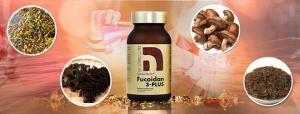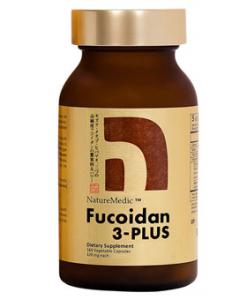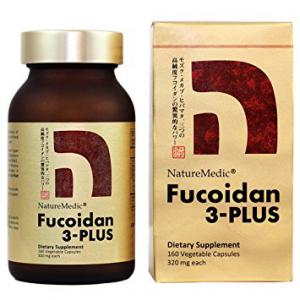
Fucoidan, from brown seaweeds, offers an anti-HIV function and Immunoregulation by Dr. Susana Trujillo
Fucoidan- sulfated polysaccharides from brown seaweeds like Mozuku, Mekabu and Fucus - has been shown to inhibit human immunodeficiency virus (HIV) infection.
The Immune System
The immune system is the body's defense against infectious organisms and other invaders. The immune system is made up of:
• Physical barriers: such as intact skin and mucous membranes.
• Chemical barriers: such as stomach acid and antibacterial substances in body fluids.
• Organs and cells: such as tonsils lymph glands and a variety of white blood cells.
How AIDS develops
In the presence of HIV, the immune system is slowly disrupted. HIV kills cells in the lymph nodes (small glands filled with immune cells that trap foreign organisms) and in other sites. This affects the balance of the immune system.5 Then, the virus levels in the blood and the lymph nodes increase because the immune system cannot keep up with the amount of virus constantly produced.6,7
HIV continually changes itself, avoiding attack by the antibodies and immune cells that normally control infections. Each generation of viruses is slightly different. This constant evolution helps HIV keep one step ahead of the immune system. Immune cells can only look for viruses that resemble the previous generation of HIV, so the virus constantly ‘escapes’ the immune system.7
CD4 T-cells gradually decline in number. This is because they are killed by HIV and because they are over-activated, and this leads to an increase in T-cell death.5,6 HIV destroys memory CD4 T-cells that have been primed to rapidly respond to infections. Therefore, infections such as Pneumocystis pneumonia (PCP) and Candida (thrush) develop when the CD4 cell count falls.7
HIV and the Immune System Response
Following the above, the presence of high levels of HIV in the body stimulates the immune system and huge numbers of HIV-specific CD4 T-cells are produced to contain the virus. However, these activated CD4 T-cells are also prime targets for the virus and can be rapidly infected and destroyed, leaving the body with weakened anti-HIV immune responses.8,9
Long-term non-progressors tend to maintain high levels of HIV-specific CD4 T-cells and CD8 T-cells that effectively control HIV replication and keep viral loads low.10,11 Stronger HIV-specific CD8 T-cell responses are significantly associated with greater viral load decline during primary infection.12,13 CD8 T-cells act against HIV in primary infection by killing HIV-infected cells and secreting chemokines.14,15
Fucoidan’s anti-HIV function
Fucoidan can protect healthy cells from becoming infected with the HIV/AIDS virus – in turn, Fucoidan can keep the virus from infecting those who have not contracted it.
Isolated Fucoidans from several brown seaweeds, for example, Undaria pinnatifida (Mekabu), Cladosiphon okamuranus (Mozuku) and Fucus vesiculosus (Fucus) exhibited potential antiviral effects against HSV-1 and HSV-2 deprived of cytotoxicity for Vero cell cultures. Elizondo-Gonzalez and colleagues reported that the isolated Fucoidan from Cladosiphon okamuranus (Mozuku) showed potent antiviral activity against Newcastle disease virus in the Vero cell line at the initial stages of infection. The viral formation declined by exposure of Fucoidan prior to cleavage of the fusion protein, which led to attachment of Fucoidan to the F0 protein. This finding was important to reassure that Fucoidan has anti-viral activities. Consequently, Fucoidan exhibited a better antiviral potency than ribavirin.17 Moen and Clark, 1993, studied isolated Fucoidan from F. vesiculosus, which showed its potential to suppress HIV RT in vitro.
Other studies showed that respective activities are not because of dispatching of target cells. Indeed, Fucoidan induced no adverse effects on protein metabolism and cell generation.16 HIV-1 infection of target cells is protected after preincubation with Fucoidan. Moreover, Fucoidan can effectively augment immune system health by activating immunoreactions of the cellular and humoral types and by increasing macrophage phagocytosis. In conclusion, Fucoidan directly affects the secretion of extracellular matrix proteins, influences the proliferation of cells, and can activate apoptosis.17 Scientists also examined Fucoidan for its anti-HIV-1 abilities, given its potent anti-herpetic properties. This anti-HIV-1 activity was not a result of Fucoidan working as a viricidal, but rather as a direct consequence of its ability to inhibit the early events of viral replication with Fucoidan. Moreover, Fucoidan can effectively augment immune system health by activating immunoreactions of the cellular and humoral types and by increasing macrophage phagocytosis.18 In conclusion, Fucoidan directly affects the secretion of extracellular matrix proteins, influences the proliferation of cells, can activate apoptosis and support the immune function.18
References:
1. Damonte E.B., Matulewicz M.C., Cerezo A.S. Sulfated seaweed polysaccharides as antiviral agents. Curr. Med. Chem. 2004;11:2399–2419. doi: 10.2174/0929867043364504. [PubMed]
2. McClure M.O., Moore J.P., Blanc D.F., Scotting P., Cook G.M., Keynes R.J., Weber J.N., Davies D., Weiss R.A. Investigations into the mechanism by which sulfated polysaccharides inhibit HIV infection in vitro. AIDS Res Hum Retroviruses. 1992 Jan;8(1):19-26.
3. 5. Ghosh T., Chattopadhyay K., Marschall M., Karmakar P., Mandal P., Ray B. Focus on antivirally active sulfated polysaccharides: From structure-activity analysis to clinical evaluation. Glycobiology. 2009;19:2–15. [PubMed]
4. Routy JP et al. Comparison of clinical features of acute HIV-1 infection in patients infected sexually or through injection drug use. The investigators of the Quebec Primary HIV Infection Study. J Acquir Immune Defic Syndr 24: 425-432, 2000
5. Aasa-Chapmen MM et al. Detection of antibody-dependent complement-mediated inactivation of both autologous and heterologous virus in primary human immunodeficiency virus type 1 infection. J Virol 79: 2823-2830, 2005
6. Huber M Complement lysis activity in autologous plasma is associated with lower viral loads during the acute phase of HIV-1 infection. PLoS Med 3(11): e441, 2006
7. Goujard C et al. CD4 cell count and HIV DNA level are independent predictors of disease progression after primary HIV Type 1 infection in untreated patients. Clin Inf
MARTHA TRUJILLO
1984
+1 9292154000
email us here
EIN Presswire does not exercise editorial control over third-party content provided, uploaded, published, or distributed by users of EIN Presswire. We are a distributor, not a publisher, of 3rd party content. Such content may contain the views, opinions, statements, offers, and other material of the respective users, suppliers, participants, or authors.




